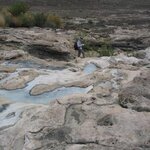Environment

Throughout history, the changing fortunes of human societies in Asia have been linked to variations in the precipitation resulting from seasonal monsoons. A new paper published in the British journal Nature Geoscience suggests that variations in monsoon climate over longer time scales also influenced the evolution of the world's highest mountain chain, the Himalaya.
The climate over much of Asia is dominated by seasonal winds that carry moist air over the Pacific Ocean into East Asia and over the Indian Ocean into South Asia. The East and South Asian monsoons are responsible for most of the…

Chinese history is replete with the rise and fall of dynasties, but researchers now have identified a natural phenomenon that may have been the last straw for some of them: a weakening of the summer Asian Monsoons. Such weakening accompanied the fall of three dynasties and now could be lessening precipitation in northern China.
Results of the study, led by researchers from the University of Minnesota and Lanzhou University in China, appear in this week's issue of Science. The work rests on climate records preserved in the layers of stone in a 118-millimeter-long stalagmite found…

Scientists say that a type of rock found at or near the surface in the Mideast nation of Oman and other areas around the world could be harnessed to soak up huge quantities of globe-warming carbon dioxide. Their studies show that the rock, known as peridotite, reacts naturally at surprisingly high rates with CO2 to form solid minerals—and that the process could be speeded a million times or more with simple drilling and injection methods.
Peridotite comprises most or all of the rock in the mantle, which undergirds earth's crust. It starts some 20 kilometers or more down, but occasionally…

Letter* published in Nature Geoscience concluded at last: Overall, despite the paucity of observations, we find that human-induced warming is detectable in both these regions of high vulnerability to climate change.
The regions in focus are the Antarctica and the Arctic region. Eight scientists from seven organizations are the researchers of this study. They used CRUTEMP3 near-surface, gridded temperature data set for January 1900- July 2008. They compared those observations with simulations from four CMIP3-coupled climate models, which are UKMO-HadCM3, PCM, CCSM3,…

The fight against climate warming has an unexpected ally in mushrooms growing in dry spruce forests covering Alaska, Canada, Scandinavia and other northern regions, a new UC Irvine study finds. When soil in these forests is warmed, fungi that feed on dead plant material dry out and produce significantly less carbon dioxide than fungi in cooler, wetter soil. This came as a surprise to scientists, who expected warmer soil to emit larger amounts of carbon dioxide because extreme cold is believed to slow down the process by which fungi convert soil carbon into carbon dioxide.
Knowing how…

Take a close look at that cheap piece of scrap iron before you toss it in the trash. Wei-xian Zhang has a good use for it. Someday soon, much of the world might also. Zhang, a professor of civil and environmental engineering, recently concluded a five-year research project in which he and his colleagues at Tongji University in Shanghai used two million pounds of iron to detoxify pollutants in industrial wastewater.
The project, carried out in Shanghai, was the largest in history to use iron in an environmental application. The iron, called zero valent iron (ZVI) because it is not…

Halloween is a holiday with lots of creepy wildlife associated with it, but are they really so creepy? From toads to bats to owls, the National Wildlife Federation shares the facts about these animals and what they are up to at this time of year, which might dispel a few myths.
Bats - are they out for my blood?
Blood sucking vampire bats are real – but they mostly feed on chickens and cows and only live in Latin America. Most North American bats are insect eaters, feeding on everything from moths to mosquitoes to beetles. They use echolocation to find their prey, which is kind of like radar…

Current models of global climate change predict warmer temperatures will increase the rate that bacteria and other microbes decompose soil organic matter, a scenario that pumps even more heat-trapping carbon into the atmosphere. But a new study led by a University of Georgia researcher shows that while the rate of decomposition increases for a brief period in response to warmer temperatures, elevated levels of decomposition don't persist.
"There is about two and a half times more carbon in the soil than there is in the atmosphere, and the concern right now is that a lot of that carbon is…

Childhood obesity can lead to type 2 diabetes, asthma, hypertension, sleep apnea and emotional distress. Obese children and youth are likely to be obese as adults, experience more cardiovascular disease, high blood pressure and stroke and incur higher healthcare costs. In an article published in the December 2008 issue of the American Journal of Preventive Medicine, researchers report that children living in inner city neighborhoods with higher "greenness" experienced lower weight gains compared to those in areas with less green space.
Researchers from the University of Washington, Indiana…

Methylmercury is a chemical compound formed in the environment from released mercury. Unfortunately, the methylmercury can be transported quickly around the body and may enter the brain. In a pregnant mother, serious problems will ensue if important developmental processes are blocked. There's only one chance for a baby brain to develop.
Recent studies hint that exposure to the toxic chemicals such as methylmercury can cause harm at levels previously considered safe. A new analysis of the epidemiological evidence in the International Journal of Environment and Health suggests that we…